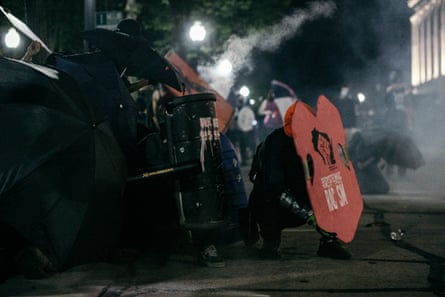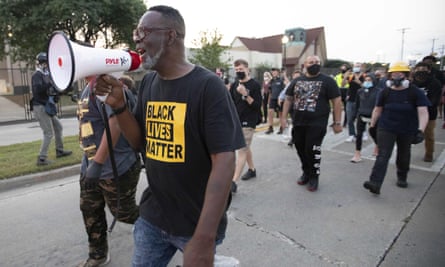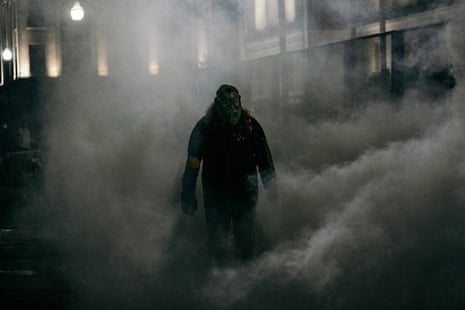The shaken residents of Kenosha woke up on Wednesday to warm lakeside sunshine but a tense atmosphere after events spiraled suddenly into fatal violence the night before when armed, white agitators appeared on the streets and at least one opened fire on those protesting against the police shooting of a local Black man on Sunday.
The overnight shootings, described by authorities as likely vigilantism that killed two, have plunged the small city on the shores of Lake Michigan into crisis.
Tensions were high even before the reported white nationalist militia members arrived to confront Black Lives Matter protesters with apparent impunity, despite a strong local and state law enforcement presence downtown.
Largely peaceful protests prompted by the catastrophic wounding of local father Jacob Blake by the police on Sunday had been marred by the kind of arson attacks and clashes that leave a glaring physical mark on a city, spawning viral videos, and often eclipsing images of calm, chanting marchers demanding systemic change.
Before the apparent vigilante attacks late on Tuesday, rattled residents had already been speaking out ruefully, against a backdrop of boarded-up buildings, about recent budding signs of better race relations in the small Wisconsin city, now crushed.
Dozens of buildings and businesses have been destroyed in unrest since Sunday, notably the Kenosha department of corrections office, but also many local shops.
“These family-owned stores were backing Black Lives Matter and still got burned down. Something doesn’t feel right, it’s like a stab in the back,” Glenn Summers, a Black native and longtime resident of Kenosha, told the Guardian on Tuesday evening as protesters marched peacefully in the run-up to the 8pm curfew in operation since Blake was shot.
Summers said improved racial relations were beginning to blossom in Kenosha before the police shooting.
Local businesses and restaurants had met the call for racial justice that grew into a national and international cry following the police killing of George Floyd in Minneapolis in May, he said.
Many began openly displaying support for the Black Lives Matter movement for the first time.
“But now many of those businesses are destroyed,” he said.

The sad taking stock on Tuesday came amid pleas from the mother of Jacob Blake, Julia Jackson, for healing and calm that clearly have not been heeded by all.
Relations between African American communities and the police in Kenosha had long been fraught.
“The cops and the people in the courthouse and jails say they care about Kenosha, but they really don’t care about making it a nice place for everyone,” Summers said.
He added: “I’m scared to walk outside sometimes because the last time I was pulled over, there were multiple cops pointing assault rifles at me just because someone called the cops on me. I was unarmed.”
Largely peaceful protests since Blake was shot in the back in front of his three young sons on Sunday had already deteriorated on the fringes into daily scuffles between sheriffs and national guard troops sent in by the governor of Wisconsin, Democrat Tony Evers.
The results have been some protesters throwing fireworks and water bottles while law enforcement responded with teargas and armored vehicles, and on Tuesday night a relatively peaceful atmosphere quickly spiraled.

This despite Blake’s mother Julia Jackson leaving an emotional family press conference on Tuesday afternoon saying her son would not approve of violent unrest and addressing a protester loudly chanting “No justice, no peace.”
Jackson said, talking softly from behind a mask to protect against the coronavirus: “Please stop the violence. Keep your dollars in the Black community. Hit them where it hurts.”
She had earlier visited her son in hospital, who later underwent emergency surgery but is currently paralyzed from the waist down.
Blake’s uncle, Justin Blake, said on Wednesday morning that his nephew, whom he called “Little Jake” was “out of the woods” since emerging from surgery, but the 29-year-old was in a lot of pain and it is unclear if the paralysis is temporary.
Having seen the bystander video of his nephew being shot in the back by a police officer, Justin Blake told ABC TV: “It was definitely a racial issue. It’s highly discouraging that we live in America in 2020 and parents are still having to tell young Black men to be careful when they walk out the door of law enforcement officers who we pay to protect us.”
On Tuesday evening in downtown Kenosha, a city of around 100,000 on the shore of Lake Michigan, about 40 miles south of Milwaukee, resident TW Gordon said the shooting of Blake on Sunday was “far from an isolated incident”.
“We’ve seen too many mistakes. Excuses have run dry. It’s obvious now that it’s just racism,” he told the Guardian.
Gordon has lived in Kenosha county for decades and has seen the police department and community transform before his eyes, he said.
In a largely white state, Kenosha is one of the Blackest cities in Wisconsin with a population that is 11% African American.
Gordon said he believes that developments in industry and infrastructure in recent decades have favored the rural communities that are mainly white at the expense of more urban communities of color.
While Black and Latino people make up 25% of the cities population, they account for 40% of people in the city living in poverty.
And public funding skews in the wrong direction, he said.
“The police are taking too much money to make too many mistakes. We need to invest that money into our community so that our Black kids can get the resources they need to succeed just like the white folks here,” Gordon said.

Even before a fatal gunfire rang out on Tuesday night after apparent white counter-protesters got involved with Black marchers, a calm protest of about 100 people walking and about 20 cars accompany from the county courthouse for two hours, the procession passed business owners standing in front of their stores carrying assault rifles.
Sarah Ferrow, who lives a few blocks away from the center of the protests, has been out demonstrating every day since the shooting of Blake.
“People from out of town are coming here and setting our community on fire. The only place that was good to burn down was the [department of corrections],” she said, adding: “They’re only doing this because they don’t live here. I shouldn’t have to board up my house and be scared that people are going to destroy it.”
Ferrow said she wishes that instead of energy being used to destroy the city and money being used to police Kenosha residents that the community could just get more of what they need to survive.
“We need so many things around here. We need homes for houseless people. We need more food banks and we need money going to our schools. What we don’t need is all the money going to this mess,” she said.
